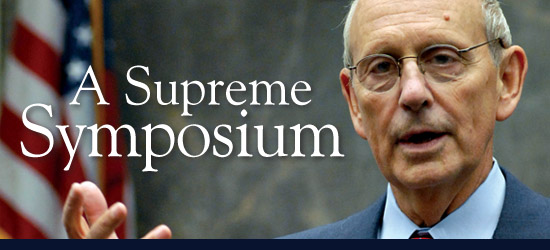
Jessica McConnell
U.S. Supreme Court Justice Stephen G. Breyer Commemorates Groundbreaking Media Access Article At Gw Law Conference
By Jamie L. Freedman

|
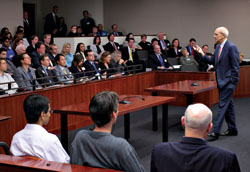
Breyer addresses attendees at the GW Law Review symposium commemorating Professor Jerome A. Barron’s landmark 1967 article “Access to the Press—A New First Amendment Right.”
Abdul El-Tayef/WPPI.com
|
Law School welcomed U.S. Supreme Court Justice Stephen G. Breyer to campus on Oct. 11 to kick off a two-day symposium commemorating the 40th anniversary of GW Law Professor Jerome A. Barron’s seminal article on media access. The Jacob Burns Moot Courtroom was packed for the opening event of the conference, which brought together scholars from across the nation to debate leading issues related to the landmark article, “Access to the Press—A New First Amendment Right.”
“Jerry Barron honors us by letting us honor him through this symposium,” GW Law School Dean Frederick M. Lawrence said in his welcoming remarks. “While questions relating to the media have changed dramatically over the years, Jerry Barron’s ideas have remarkable staying power and continue to intrigue us 40 years after he wrote his path-breaking article.”
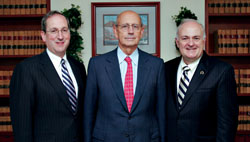
Dean Lawrence (left) welcomed visitors to the symposium at the opening of the event with Justice Breyer (center). GW President Steven Knapp (right) also attended the event.
Abdul El-Tayef/WPPI.com
|

|
Robert Brauneis, associate professor of law, introduced Breyer—whom he clerked for at the U.S. Court of Appeals for the 1st Circuit. Emphasizing that Breyer’s interpretation of the law made him a “particularly appropriate” keynote speaker for the event, he stated: “[Breyer] looks for the deepest themes that underlie the Constitution and how those themes guide us, not only in constitutional interpretation but in statutory interpretation and administrative law.” Breyer and Barron also share “a very practical view of the relationship between freedom and democracy,” he stressed.
In his spirited remarks, Breyer lauded Barron and his groundbreaking Harvard Law Review article. “Both are worth celebrating,” he stated. “I could not be more pleased to be here at the beginning of what I’m sure will be a very valuable conference.”

|
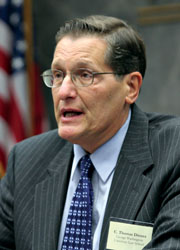
Barron’s colleague and friend, GW Law Professor C. Thomas Dienes, moderated one of the event’s panels. Dienes and Barron have written several books together, including the Constitutional Law in a Nutshell series.
Abdul El-Tayef/WPPI.com
|
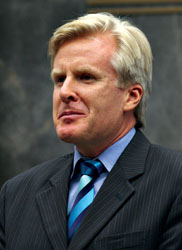
Professor Robert A. Brauneis, who clerked for Justice Breyer at the 1st U.S. Circuit Court of Appeals, introduced Justice Breyer at the event.
Abdul El-Tayef/WPPI.com
|
Breyer enthusiastically outlined why he admires the 1967 article, citing its practical perspective and the fact that it pushes readers to think about democracy and how it best functions. “The article focuses on the democratic process in action and forces us to think about the kind of country and democracy we want,” he said. “I hope the subterranean message is that there is room in the law school profession for the kinds of articles that look at how law is working out in the real world and discuss how things can be done better.”
Breyer confessed that he likes the article for “totally selfish” reasons, as well. “It helps us decide cases,” he said, noting that the article contains “germs of ideas” that are of practical use in the decision-making process. He said that he is pleased the symposium is inspiring people to read the article again.
Throughout his remarks, the former Harvard Law professor exhibited his quick wit and relaxed style of lecturing—eliciting spontaneous eruptions of laughter and applause. Breyer’s remarks set the stage for four panel discussions on media access, moderated by GW Law faculty members and hosted by GW’s Law Review. Topics included Access and the Regulatory State, Access and First Amendment Theory, Intellectual Property and Access for Ideas, and Rights of Reply in Comparative Law.
|